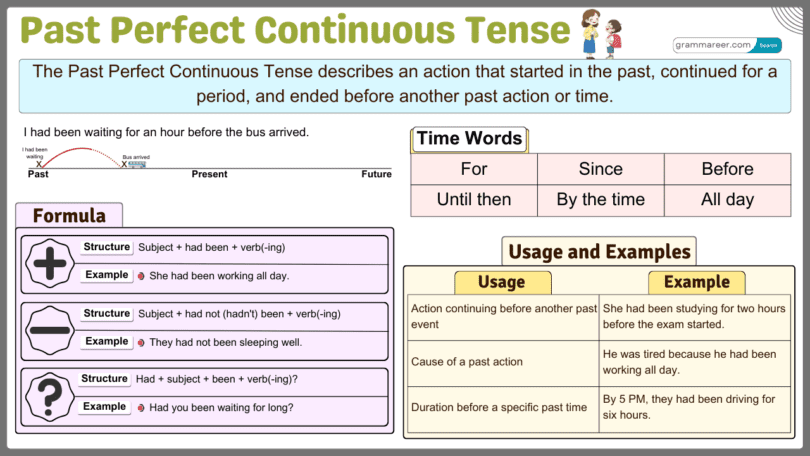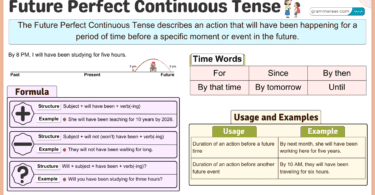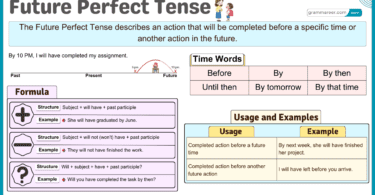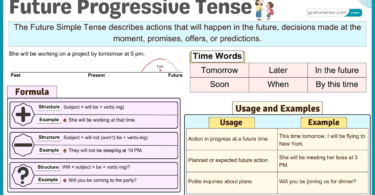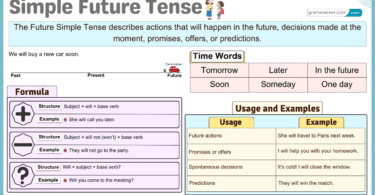The Past Perfect Continuous Tense is a key part of English grammar, used to describe actions that started in the past, continued for some time, and were completed before another action or time in the past. This tense emphasizes the duration of an activity. Understanding the structure and uses of the Past Perfect Continuous Tense will help you improve both speaking and writing skills, especially when narrating past events with a focus on duration.
Table of Contents
Sentence Structures of the Past Perfect Continuous Tense
The Past Perfect Continuous Tense has three main structures: affirmative, negative, and interrogative sentences.
Affirmative Sentences
Structure: Subject + had been + Verb + -ing + Object
Examples:
- Aisha had been reading a book for two hours before dinner.
- They had been playing football when it started to rain.
In both examples, had been is used for all subjects, followed by the -ing form of the main verb.
Negative Sentences
Structure: Subject + had not been + Verb + -ing + Object
Examples:
- Bilal had not been watching TV before bedtime.
- We had not been eating healthy food until recently.
You can also use the contraction hadn’t been instead of had not been:
- Bilal hadn’t been watching TV.
Interrogative Sentences
Structure: Had + Subject + been + Verb + -ing + Object + ?
Examples:
- Had Hamza been studying for the exam before the test day?
- Had they been traveling for long before the storm started?
Double Interrogative Sentences
Structure: Question Word + had + Subject + been + Verb + -ing + Object + ?
Examples:
- What had Fatima been doing before she left?
- Where had they been going before the event?
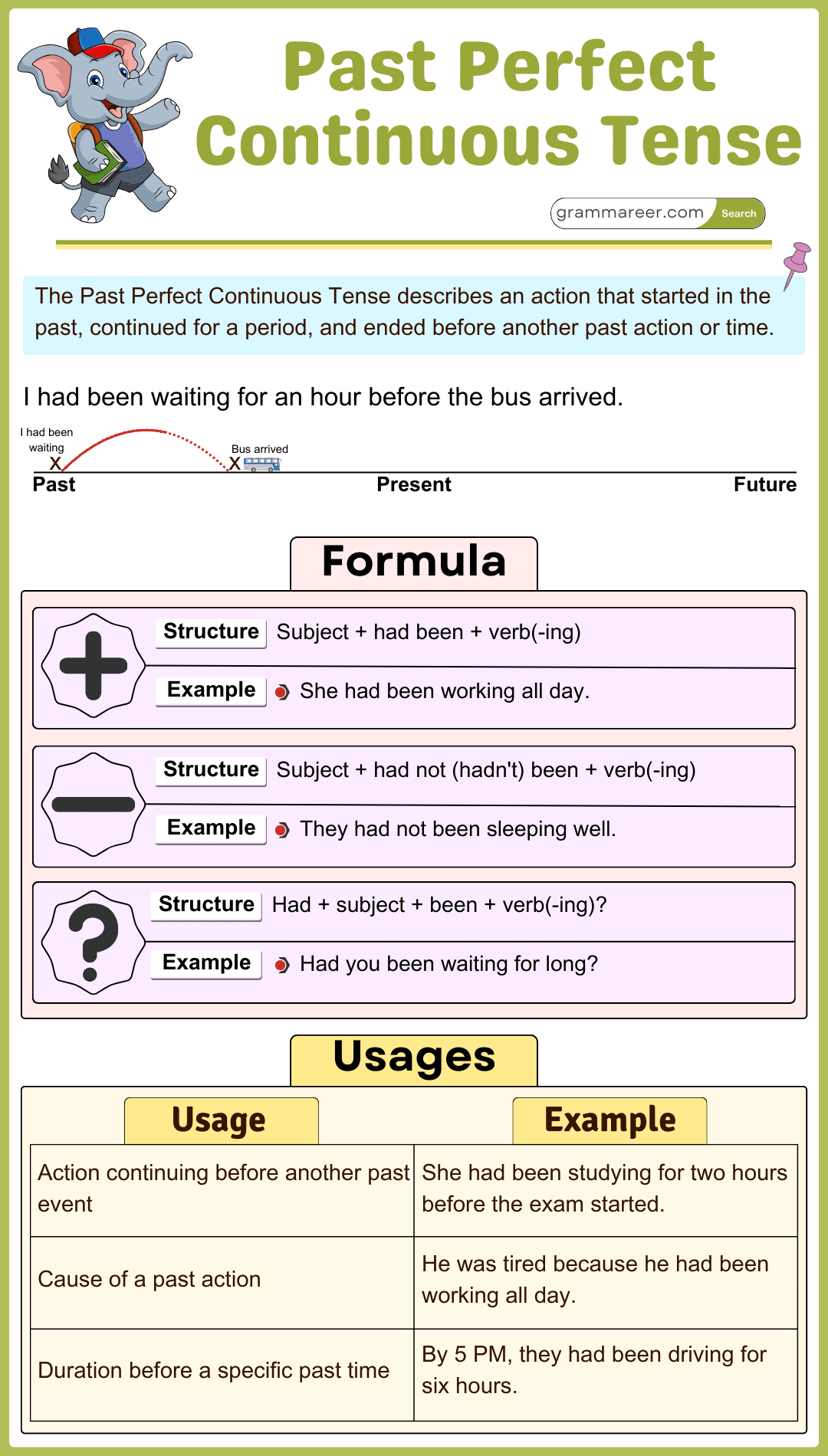
Subject-Verb Agreement in Past Perfect Continuous
In the Past Perfect Continuous Tense, had been is used with all subjects, both singular and plural.
| Subject | Helping Verb | Main Verb Example |
|---|---|---|
| I | had been | had been studying |
| You | had been | had been playing |
| He/She/It | had been | had been writing |
| We/They | had been | had been learning |
| The teacher | had been | had been explaining |
| My parents | had been | had been traveling |
Time Expressions in Past Perfect Continuous
Common time expressions used with the Past Perfect Continuous Tense include:
- For: She had been working here for five years before she resigned.
- Since: They had been studying since morning when the class ended.
- Before: I had been waiting before they arrived.
- By the time: By the time we reached, he had been sleeping for hours.
- When: She had been crying when I met her.
Adverb Placement in Past Perfect Continuous
Adverbs like always, constantly, just, recently are placed before the main verb.
Examples:
- He had always been thinking about moving abroad.
- They had recently been working on a new project.
Uses of the Past Perfect Continuous Tense
The Past Perfect Continuous Tense is used to describe actions that started in the past, continued for some time, and were still happening or had just finished before another action or time in the past. It is formed using had been + verb + ing.
1. Actions That Continued Up to a Point in the Past
It describes actions that started earlier and were still happening up until a specific time or event in the past.
- She had been studying for hours before she finally took a break.
- They had been waiting for the bus when it suddenly arrived.
2. Actions That Had Recently Stopped with Visible Results
It shows that an action had just finished before another past event, and the effects were still noticeable.
- He was tired because he had been running.
- Her hands were dirty because she had been gardening.
3. Showing the Duration of a Past Action
It emphasizes how long an action had been happening before another action or time in the past, often with time expressions like for and since.
- They had been living in New York for five years before moving to Chicago.
- I had been working at that company since 2010 when I decided to quit.
4. Explaining the Cause of a Past Situation
It explains the reason for a past situation, focusing on the ongoing activity that caused it.
- She was upset because she had been arguing with her friend.
- The ground was wet because it had been raining.
Short Answers in Past Perfect Continuous
When answering questions in the Past Perfect Continuous Tense, short answers are commonly used to confirm or deny information. These answers are brief but grammatically correct, helping to keep conversations clear and concise.
| Question | Short Answer |
| Had you been working hard? | Yes, I had. |
| Had she been studying a lot? | No, she hadn’t. |
| Had they been waiting long? | Yes, they had. |
| Had Ahmed been reading? | No, he hadn’t. |
Question Tags in Past Perfect Continuous
Question tags are short questions added at the end of a statement to confirm information or seek agreement. In the Past Perfect Continuous Tense, question tags are formed using hadn’t for positive statements and had for negative statements.
| Sentence | Question Tag |
| You had been working hard, hadn’t you? | hadn’t you? |
| He had been playing football, hadn’t he? | hadn’t he? |
| They had been traveling, hadn’t they? | hadn’t they? |
| She had been studying, hadn’t she? | hadn’t she? |
Examples of Past Perfect Continuous in Use
Here are more examples to help you understand the Past Perfect Continuous Tense:
- Affirmative:
- Hassan had been eating lunch for 30 minutes before the meeting.
- We had been living in Karachi for five years before moving.
- She had been practicing the piano since morning.
- They had been working on the project for two months before submitting it.
- Negative:
- She had not been listening to music before the event.
- They had not been attending classes regularly.
- Boby hadn’t been feeling well before the doctor’s visit.
- We had not been expecting such a quick response.
- Interrogative:
- Had you been understanding the lesson before the break?
- Had Malaika been learning Urdu before moving abroad?
- Had they been living in the city for a long time?
- Had she been working late every day?
Common Mistakes with Past Perfect Continuous
Many learners make errors in this tense. Here are some common mistakes and their corrections:
- ✅ She had been studying for two hours before dinner.
- ❌ She was studying for two hours before dinner.
- ✅ They hadn’t been waiting for long.
- ❌ They don’t been waiting for long.
- ✅ Had you been reading this book before?
- ❌ Did you been reading this book?
- ✅ The baby had been sleeping since 8 PM.
- ❌ The baby was sleeping since 8 PM.
FAQs
The Past Perfect Continuous Tense is used for actions that continued up to another past event, emphasizing duration, and describing causes of past situations.
Past Perfect focuses on completed actions (I had finished my work), while Past Perfect Continuous focuses on ongoing actions with duration (I had been working for hours).
Subject + had been + verb (base form + ing) + object + (since/for + time reference).
They had been working on the project for two weeks.
Subject + had not been + verb (base form + ing) + object + (since/for + time reference).
She had not been feeling well since Monday.
Had + subject + been + verb (base form + ing) + object + (since/for + time reference)?
Had they been studying for the exam for two hours?
Use had been at the beginning. Example: “Had you been studying?” For all subjects, use had been with the -ing form of the verb.
You May Also Like

